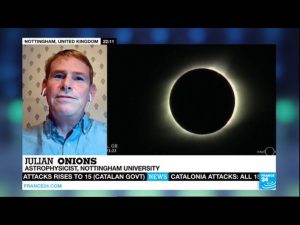
August 22, 2017, by Lindsay Brooke
Eclipse news from the School of Physics and Astronomy
Among the millions who watched the first total solar eclipse to be seen across America for nearly a century was Professor Mike Merrifield, Head of the University of Nottingham’s School of Physics and Astronomy. Here’s one of the pictures he took as he joined an excited crowd in Central Park, New York.
He said: “Clouds around, but they did enable one good shot.”
And while Mike was able to see the eclipse for real Astrophysicist Dr Julian Onions, also from the School of Physics and Astronomy, was helping out international news TV station France24 with their eclipse coverage.
Here are some eclipse tips from Dr Onions:
A partial eclipse – where only a bit of the sun is obscured. We saw a partical eclipse in Europe this time, but only a tiny fraction of the sun was obscured.
A full ecipse – like the US eclipse, where the whole of the sun is blocked by the moon.
An annular eclipse – this is like a full eclipse, but as the moon happens to be further away on it’s elliptical orbit it can’t block the whole sun, so a compete ring is visible when it would have been a full eclipse otherwise.
A lunar eclipse – where the Earth blocks the sun on the moon. If we had astronauts on the moon they would be able to see that. As the Earth is much bigger, it covers all of the moon usually.
The next total eclipse is in 2019 over Argentina and Chile.
The next European eclipse is in 2026 which covers some of Spain – annoyingly Spain will get another one in 2027!
The moon is moving away from the Earth about about 2cm a year, so eventually all eclipses will be annular, but not for around 600 million years.
The generic word for any eclipse is a syzygy (which scores a lot in scrabble) where one object blocks the light of another.
No comments yet, fill out a comment to be the first



Leave a Reply